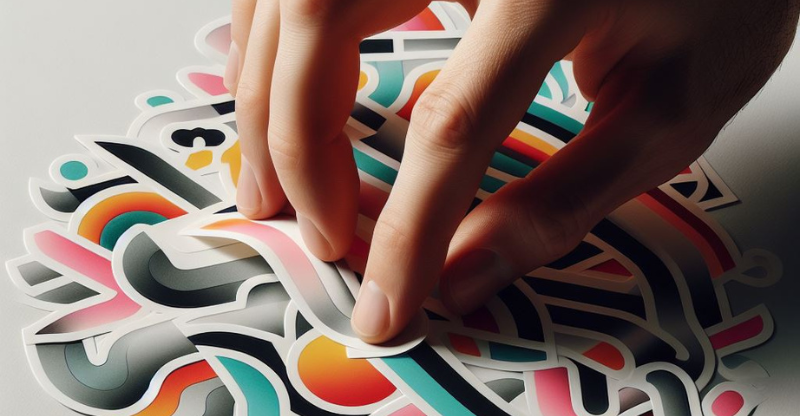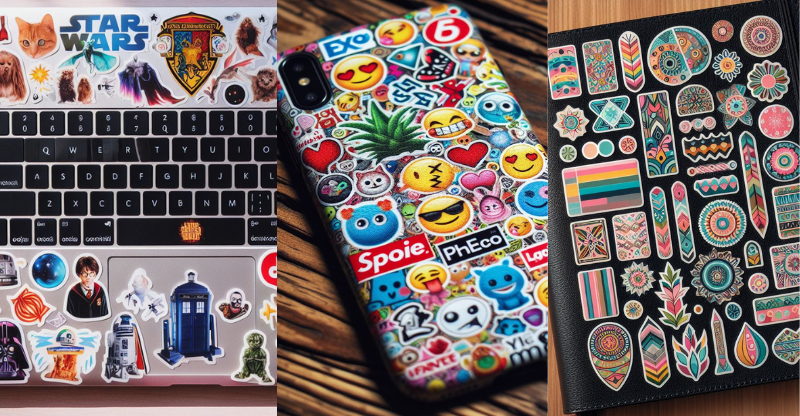Stickers are a popular way to personalize and decorate items, from laptops and water bottles to car bumpers and walls. However, the frustration of having your favorite stickers peel off can diminish the joy they bring. The key to ensuring that stickers stay in place is understanding why they peel and how to prevent it. Primarily, the adhesive backing of a sticker and the type of surface it’s adhered to play significant roles in determined longevity.

The longevity of a sticker depends on proper surface preparation and application. Before applying a sticker, it’s essential to make sure that the surface is clean, dry, and free of debris which could interfere with adhesion. Once applied, taking steps to secure the sticker’s adhesion will increase its resistance to peeling. This could involve the use of additional sealants, choosing the right sticker material for the intended use or environment, and routine maintenance to ensure the sticker remains affixed.
Key Takeaways
- Sticker longevity hinges on the quality of the adhesive and the preparation of the surface it’s applied to.
- Proper application techniques contribute significantly to preventing stickers from peeling.
- Routine maintenance and protective measures can enhance the durability of stickers.
Choosing the Right Stickers

To ensure longevity and performance, one must carefully select stickers with appropriate materials, verify surface compatibility, and opt for durable stickers suited for their intended use, whether for indoor or outdoor placement.
Assess Sticker Material
The material of a sticker determines its resistance to elements and wear. Vinyl stickers are a popular choice due to their durability and waterproof characteristics, making them suitable for both indoor and outdoor use. They resist fading and peeling when exposed to weather conditions. Meanwhile, paper stickers are cost-effective but less durable, suitable primarily for indoor applications where they are not subjected to moisture or abrasion.
Consider Surface Compatibility
A sticker’s adhesive must be compatible with the surface it will be applied to for optimal adhesion. Self-adhesive stickers with a strong adhesive back are ideal for smooth, non-porous surfaces like glass or metal. Surfaces with textures or those exposed to heat or chemicals require stickers with specialized adhesives designed for these conditions.
Selecting for Durability
For long-lasting stickers that don’t easily peel, one must select high quality stickers crafted from quality materials. Waterproof stickers are optimal for items that may come into contact with liquid, such as water bottles or outdoor gear. UV-resistant stickers will prevent fading and maintain their appearance when used outdoors. It’s essential to invest in high-quality, durable stickers, which often correlate with longer-lasting adhesion and resistance to peeling.
Preparation of the Surface
Proper surface preparation is crucial to ensuring that stickers adhere properly to desired surface and do not peel off. The following steps will guide you through creating a suitable foundation for sticker application.
Cleaning the Surface
Stickers require clean surfaces for optimal adhesion. Begin by removing dirt and dust from the desired area. Utilize a cleaning spray or a soft cloth dampened with water for general cleaning. For more stubborn residues, rubbing alcohol can be applied to break down oils and grime. Here’s a concise way to approach this:
- General Cleaning: Use a cleaning spray and a microfiber cloth.
- Tough Residues: Apply rubbing alcohol with a soft cloth.
Dealing with Texture
Stickers adhere best to flat surfaces. If the surface has any bumps or any texture, it’s important to ensure that the sticker is flexible or soft enough to conform to the irregularities. For lightly textured surfaces:
- Press the sticker firmly, working from one edge to the other to avoid air bubbles.
Ensuring Dryness
After cleaning, the surface must be completely dry before sticker application. Moisture can weaken the adhesive bond, leading to peeling. Dry the surface thoroughly with a lint-free towel or allow it to air dry completely. Remember:
- No Dampness: Verify that no moisture remains.
- Air Dry: Leave enough time for the surface to air dry if not using a towel.
Proper Application Techniques

Executing proper application techniques is essential to ensure stickers adhere securely and maintain their appearance over time. Attention to detail can prevent common issues such as peeling and air bubbles, especially on challenging surfaces and freshly painted walls.
Applying Without Air Bubbles
To apply a sticker without air bubbles, one should start by cleaning the target surface thoroughly, removing any dirt or oil that could prevent the sticker from sticking properly. Peeling the backing off gently and slowly, the sticker should be placed from one side to the other, using a flat tool like a credit card to smooth it out. This tool can be run across the sticker with consistent pressure to push out any trapped air.
- Initial Placement: Do not fully remove the backing at once.
- Use a Flat Tool: A credit card or similar item to smooth out the sticker.
Handling Oddly Shaped Surfaces
When dealing with custom stickers with an oddly shaped surface, the key is to use flexible transfer tape to secure the sticker in place before removing the backing. This helps to maintain the sticker’s integrity without stretching or misshaping. It’s recommended to press the sticker down in sections, conforming to the surface’s contours with one’s hands or a soft cloth.
- Flexible Transfer Tape: Essential for maintaining sticker shape.
- Section-by-Section Application: Press down gradually to match the surface contours.
Preventing Edge Lift
To prevent the edges of a sticker from lifting, one must ensure all edges firmly adhere to the surface. After applying the sticker with hands, additional pressure should be applied around the edges, possibly using an old credit card to reinforce the adhesion. Attention should be given to corner areas, as they are more prone to start peeling.
- Reinforced Edges: Use an old credit card for extra pressure on edges.
- Corner Attention: Extra care to prevent peeling from corners.
Securing the Sticker’s Adhesion

Ensuring a sticker stays in place involves reinforcing its inherent adhesive qualities and manipulating factors such as temperature for optimal adhesion.
Using Additional Adhesives
Extra adhesives—when used sparingly—can greatly enhance the bonding process. For surfaces that are uneven or exposed to the elements, acrylic clear coat can act as a sealant, safeguarding both the sticker’s material and its adhesive layer. When a sticker begins to lift, a small amount of clear glue or clear nail polish can be applied to the edges of dry adhesive, thus preventing further peeling.
- Types of Additional Adhesives:
- Clear Acrylic Spray
- Decoupage Glue
- Clear Nail Polish
Note: The amount of additional adhesive used should be minimal to prevent mess and damage to the surface upon removal.
Leveraging Heat for Better Bonding
Heat can play a crucial role in the sticking process by enhancing the sticker’s adhesion to the surface. By carefully applying heat—either through a hair dryer or another gentle heat source—after the sticker is placed, one can often achieve a more secure bond. This is particularly true when dealing with environments that fluctuate in temperature, as the heat helps the adhesive to expand into the surface’s minute imperfections, creating a stronger hold.
- How to Apply Heat:
- Use a hairdryer on a low setting
- Keep the hairdryer a safe distance from the sticker to avoid overheating
- Move the heat source evenly over the surface
Attention: One must be careful not to overheat as it may cause the sticker or sticky adhesive to warp or melt.
Long-Term Sticker Maintenance

Maintaining stickers involves two critical practices: regular cleaning to prevent build-up that may weaken adhesion, and shielding from environmental elements that can lead to peeling stickers.
Regular Cleaning
Routine upkeep is essential for sticker longevity. Clean stickers regularly by gently wiping the surface with a soft, damp cloth to remove dust and grime. This prevents particulate accumulation that can create a barrier between the sticker’s adhesive and the application surface. For more stubborn dirt, a mild soap solution can be used, being sure to avoid saturating the sticker to prevent moisture damage.
Protecting from Environmental Factors
Protection from environmental factors like moisture and heat is crucial. To safeguard stickers:
- Moisture: Ensure stickers are appropriately sealed with a clear acrylic coat from Frugal Home Addict or a similar protective spray to repel water and prevent peeling.
- Heat: Avoid placing stickers on surfaces that become hot or are routinely exposed to direct sunlight. Prolonged exposure can degrade the adhesive, causing lifting or curling at the edges.
- Sealants: Consider using additional products like clear nail polish to protect the sticker’s edges and surface.
- Environment: Place stickers in areas not exposed to harsh weather conditions to help maintain their vibrancy and stickiness.
Enhancing Sticker Durability

Ensuring stickers maintain their appeal and stickiness over time requires special treatments to reduce peeling and wear. Two effective methods are sealing stickers and using protective films and coatings.
Sealing Stickers
Acrylic Clear Coat: Applying an acrylic clear coat can significantly protect stickers. Use a coat with a matte finish to avoid glossiness while preserving the sticker’s color and preventing the edges from lifting. Mod Podge can also act as a sealer; it’s a multipurpose adhesive that doubles as a sealant to protect sticker surfaces from moisture and wear.
Clear Nail Polish: For smaller stickers, clear nail polish is a convenient sealer. Brushing a thin layer over the sticker creates a transparent protective seal. Be cautious with super glue, as it can be too aggressive and may damage the sticker’s design or color.
Using Protective Films and Coatings
Laminate Sheets: Laminating stickers with laminate sheets offers a sturdy layer of protection against water, scratches, and UV rays. This approach works exceptionally well for larger stickers or decals placed in high-touch or outdoor areas.
Protective Film and Tape: Both clear tape and packaging tape can be used to cover stickers, providing a quick and simple barrier against external elements. While protective film is specifically designed for this purpose, it may offer a stronger and more durable shield against the elements than standard tapes.
Incorporating these treatments can greatly extend the life of stickers by providing an extra layer of defense against peeling, fading, and damage.
Preventative Measures

To ensure stickers stay affixed, one must approach the application process of permanent adhesive with precision and care. These preventative steps can significantly reduce the risk of stickers peeling off or leaving behind residue.
Avoiding Common Mistakes
- Surface Preparation: A clean, smooth surface is paramount. Any dirt or grime can inhibit adhesion, leading to peeling. Applying an acrylic clear coat can further protect against moisture.
- Correct Material: Select stickers with a high-quality adhesive specific to the intended surface and environmental conditions. Stickers meant for outdoor use typically have stronger adhesives to withstand the elements.
Advice for Nonpermanent Applications
- Adhesive Primers: When a sticker needs to stay in place temporarily, consider using an adhesive primer for better grip. Apply it on the surface before sticker application, as this can prevent peeling and leaving behind residue.
- Peel-and-Stick Decals: For items like peel-and-stick decals, warming them slightly can enhance flexibility and adherence. Always press firmly to the surface to establish a strong initial bond and prevent future peeling.
Creative Uses and Decoration

Stickers are versatile and dynamic tools for personalizing and enhancing various items and spaces. They can serve as both aesthetic and expressive decorations, as well as collectible items with trade value. Optimizing sticker use can transform ordinary objects with uneven surfaces into unique, eye-catching pieces.
Stickers as a Decorating Tool
Stickers are a cost-effective and creative way to decorate personal items like laptops or guitars, to adding a personal touch to vehicles through bumper stickers and decals. Wall stickers can be used to revitalize spaces within a home without the commitment of paint or wallpaper. They come in an array of designs suited for different themes and age groups. For durability, apply an acrylic clear coat to prevent stickers from peeling and protect them from moisture.
- Personal Items: Laptops, guitars, water bottles
- Vehicles: Bumper stickers, decals
- Home Spaces: Wall stickers
Collecting and Trading Stickers
Sticker collections can be both a hobby and a social activity, with individuals collecting and trading stickers of various designs, such as limited edition labels and iconic decals. Collectors often use stickers to customize their personal space, showcasing their collection on items like notebooks or storage binders. For those involved in the trading community, stickers can be a form of currency and are often traded based on rarity, design, or personal preference.
- Hobbies: Collecting rare or themed stickers
- Social: Trading stickers with peers
- Display: Showcasing stickers on notebooks, binders
Specialty Sticker Considerations

When dealing with stickers that must withstand specific conditions or require easy removal, one must consider certain techniques and materials. These can range from selecting the right type to the method of application.
Waterproof and Outdoor Stickers
For stickers that will be exposed to the elements, waterproof stickers are essential. One should use adhesive vinyl for its durable and water-resistant properties. Prior to application, ensuring a clean surface is key to prevent peeling. It is also beneficial to apply a layer of wax paper over the sticker during smoothing to avoid scratches that could compromise the waterproofing.
Techniques for Removable Stickers
When it comes to removable stickers, self-adhesive labels offer the convenience of repositioning without leaving residue. One technique is to use the edge of a safety pin to carefully lift stickers firmly from the edges without tearing. Make sure to apply them to surfaces that are clean and free of debris to maintain their integrity and stickiness.




